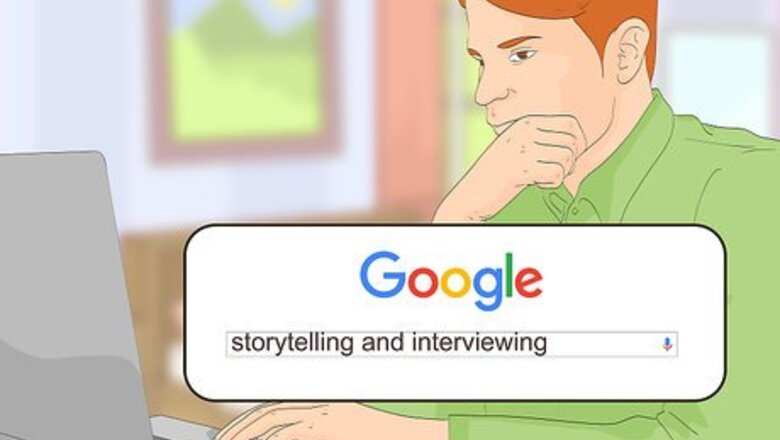
views
Planning Your Program

Search for outside resources on storytelling and interviewing. No matter if you’re writing a story or a news report, you’ll have to talk to people and catch the attention of an audience that you can engage only with words. Start with your favorite literary works, articles, and interviews, then study the pieces that are popular. Figure out why they grab your attention. Search online for guides and discussions or get popular books from a library or bookstore. A nearby college may offer classes, many of them specialized to unique focuses such as literary writing or newscasting.

Write vibrant characters. Practice this before starting a program script. Find a person who seems lively or create your own character. In as few sentences as possible, express the character's life and personality as vividly as possible. Use an important, unique detail while trying to hook the reader. It takes practice to be able to convince your listeners they should care about this person and listen to a program that includes them. Pretend that the character’s life existed before you began the story. It is helpful to take key information from before the story to set up the character’s current situation. Instead of reciting facts, insert emotions with stories and explanations. Explain the impact of a soccer game between two conflicting groups, for example. What does the game represent? How did it affect the lives of those in it?

Master simple phrasing. Radio audiences can only hear what you’re saying, so long and elaborate sentences will confuse them. While you do practice writing assignments, such as character sketches, go through and cross out all the unnecessary words. Change the complicated words. Keep the tone of your writing active instead of passive. “Newspaper editor Kurt released the article without permission” is stronger and more direct than “The article was released by Kurt, editor of the newspaper.” Most audiences will be diverse, so avoid jargon as much as possible. Explain it if you have to use it.

Research your radio spot. When you set out to write your program, you’ll first need to know the time slot and the format you will use. Is this a one-time program or a series? Will the topic continue in the next episode? You’ll need to know how much time you have to fill and whether your subject can fill it. Make each episode self-contained. If you’re preparing a series, start the next episode with fresh examples and a new approach to your subject matter.

Learn about your audience. Your program will be available to a wide variety of people and you’ll need to be able to capture the attention of as many of them as possible. Search online to find who listens to the station at your time slot, if you have one, and tailor your wording to appeal to them. The time slot matters. For instance, if your program comes on at the end of the work day after a block of music, you’ll need to get people to keep listening. You can try including comedy or appealing to their musical taste. It’s okay to target your message to the group that most tunes into your time slot, but never stereotype your audience.

Listen to good radio shows. Tune into popular shows and discover what makes them popular. The shows you like have some method of capturing your attention and keeping you listening. Note what parts make you lose interest, too. Examples can be found on standard radio, online shows, or podcasts.

Prepare interview topics. You can keep a list of important points you need to cover when speaking to someone. Look up information on the person you’re speaking to if you can, such as details about their work. Once you’ve gotten the basic information in discussion with your interview subject, try to ask your questions in a way that gets you an honest answer. Sometimes this means asking the same question several times. This is your program. Practice how to be a confident, strong, leader of it so you can keep guests from controlling it. If your program seems to be going off-topic, interrupt with questions such as “Do you have an example of that?” in order to get the information your program needs. Once you've done an interview off camera, practice cutting the audio files and inserting them at key moments into a program.

Practice speaking. Out loud, read a story you or someone else has written. You can start by using a mirror and projecting your voice through an empty room before practicing with an audience. You’ll need to speak clearly and in a way that both conveys authority and appeal. Always sound interested in the story you’re telling. Vary your pace. Like how you’d get bored listening to a bunch of songs that sound the same, your voice needs to vary to convey action and mood. Try interviewing friends or even people on the street. This gives you an opportunity to learn how to interact professionally with a wide variety of people.
Forming Your Program

Choose your topic. The most powerful topic you can choose is one that’s meaningful to you and has a lesson to offer listeners. Writing about a unique topic, such as a personal story about bullying, makes it easier for you to speak in a way that sounds personal, which keeps people interested while also making them feel like they gained meaning from listening. It’s important to choose a topic suitable to your audience. For example, people coming home from a day of work may get more out of a program with comedic elements rather than one that feels too serious.
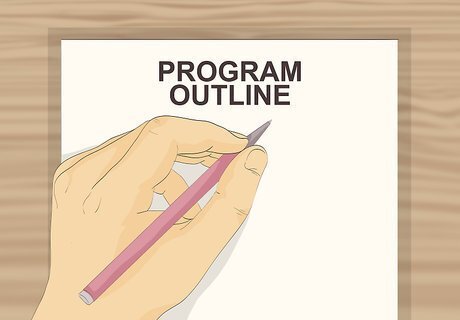
Make an outline. On paper, write down the basic parts of your script. Break the program down into segments. Note how long each segment will be and in a few words write down the points you want to make in each one. Include any breaks you’ll take and soundtracks you’ll play. All of these take up time.

Write your intro. The introduction needs to seize the attention of listeners. Decide what makes your program newsworthy. Use this to set up the plot of the story in as few words as possible. Your introduction should give the story context but also not reveal too much about the story. For example, episode 588 of the NPR podcast This American Life starts by saying, “The first thing you need to know about Laurie is that she’s normally not the kind of girl who does these kinds of things at all.” This makes you want to learn what she did and why. The introduction’s style should match that of the rest of the story. Don’t try to deceive listeners by switching tones. If the program goes on to talk about Laurie’s confliction, express the buildup to that in the introduction and maintain an informative tone. Don’t forget to introduce yourself and your program by name.

Build up your characters. The people that you will speak of are driving forces in the program. You most likely established the main one in the introduction. Now continue to grow them, having them perform actions or undergo situations that have an impact on their lives. Continue to introduce new characters as they come into the story. For example, if Laurie fell in love with a man in a magazine picture, begin to talk about how and why she did that and what consequences she experienced. Use literary tricks. For example, create suspense by mentioning that some people are in way over their heads to foreshadow that Laurie will face unexpected consequences.

Create convincing descriptions. Transition from the introduction to the body of your program by expanding upon the subject. Fill in the outline with details streamlined enough to be understood by the audience but vivid enough for them to imagine the events in the story and feel stronger emotions because of it. Show creative examples and comparisons, such as vividly describing Laurie’s infatuation with the man in the picture and her awkwardness when he called her at a later date. When you perform your program, include enough details in your outline to keep the conversation flowing. It isn’t necessary to write a complete script when you’re having conversations with guests but you do need to help them relay their message to the audience.

Master your tone. Once you’ve started filling in the details, the tone of your writing will come together. Keep the tone consistent throughout and match it to your audience while telling your story from start to finish. For example, if your goal is to address children about bullying, make sure your tone is enthusiastic, professional, but simplified enough for children to grasp. Often it is acceptable and even beneficial to mix in brief tone changes such as comedy to express Laurie’s having gotten caught in an amusing lie. You wouldn’t do this during commentary about a serious current event, so use your judgment.
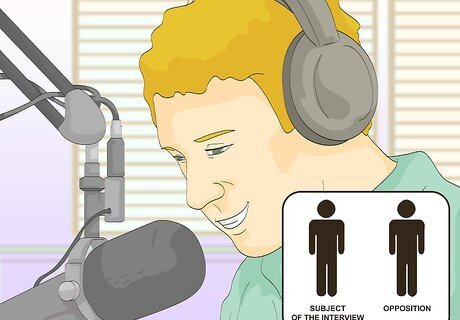
Give equal weight to opposing viewpoints. A story functions when a main character has a strong opposing force. This goes for non-fiction, too. Let the subject of your interview and their opposition have a chance to express their side of the story. Include both viewpoints in your program without offering any sort of judgment unless your program is designed to include commentary. Always be respectful at interviews. Listen to the person, show enthusiasm, and be polite. Try to speak to them on a personal level.
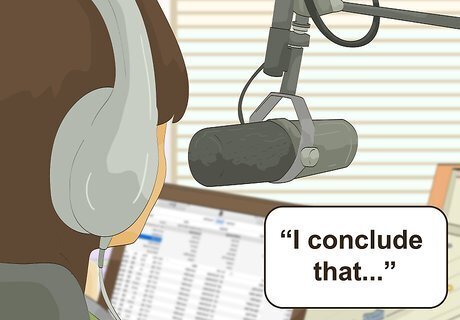
Sign off. End your script by addressing the main point from your introduction. The ending should not be a stock phrase such as “We’ll have to wait and see.” Make your ending forceful by summing up your program and concluding on a fact. Afterwards, repeat your name and the name of the program. During an interview, you can ask your guest about what they expect from the future and sum up those expectations.

Choose keywords for the show. For advertising or online categorizing, you’ll need to come up with a title, a description, and keywords. Keep the title brief, six words or less if possible, while explicitly stating what the program is about. Keep the description short and focused but have it make your script sound appealing. Your keywords should describe your program and help potential listeners search for it online. Avoid looking unprofessional. Don’t use all capitalization, profanity, or the same words for every program.

Create cohesion. If your program is recurring or a series, it helps to build a sense of unity. Edit the end of your program to introduce the next episode’s topic, if you have one. Give a brief sentence or two about the topic and link it to your current episode. If this episode links to the last one, edit your intro to remind listeners of the common thread the episodes share. Don’t forget to sign off with your name, the title of your show, and any other relevant information about the show or the next episode, such as when it will air.
Broadcasting Your Program

Log audio. If you’ve made recordings such as interviews or reporting, listen to the tape. Make annotations identifying who’s speaking, what they’re saying, and how long the parts of the recording are. Save the one you want to use in your broadcast.

Que your audio files. Load up all the songs, sound effects, and audio tracks you plan on using. These you should have ready at the push of a button so that your program flows freely. Test these files out to see if there are any volume or distortion issues that need to be fixed. If you’re going to have guests in person or calling in, make sure they can be heard if you plan on playing the files while they speak.

Conduct a test show. Choose a time when your studio is quiet and record a test as if it’s the real show. Run through the script, playing any audio files you plan on using. Test out call-in phone lines if you’re using them. After you’re done, play back the recording, listening for weak phrases, sound file errors, and other mistakes you can improve. If you’re going to have a guest, now is a good time to include them. Conclude how and when they’re going to call in or visit. If you can, run through the script with them.
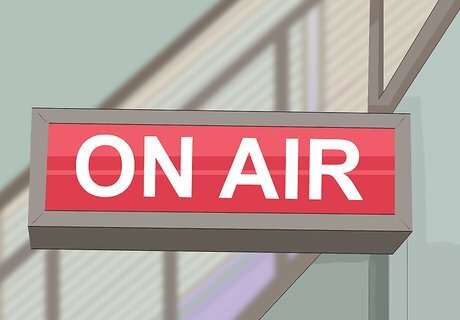
Start the official broadcast. Right before you begin, double check to make sure all of your audio files are ready and your equipment works. All that’s left is to wait for the time when the show starts. If it isn’t a live program, you can start it as soon as you feel ready. Schedule a time when your environment is quiet and you’ll have enough time to finish the broadcast.


















Comments
0 comment